Job Welcome Letter
[Your Company Logo]
[Company Name]
[Company Address]
[City, State, ZIP Code]
[Date]
[Employee's Name]
[Employee's Address]
[City, State, ZIP Code]
Dear [Employee's Name],
We are delighted to extend a warm welcome to you as the newest member of the [Company Name] team! We were thoroughly impressed with your qualifications, experience, and enthusiasm during the interview process, and we are confident that you will make a valuable contribution to our organization.
Your role as [Job Title] will play an integral part in our mission to [briefly mention company mission/goals]. We believe that your skills and expertise align perfectly with the responsibilities of the role, and we are excited to see the impact you will have on our team and projects.
Your first day of employment will be on [Start Date], and you should plan to arrive at [Office Location] at [Start Time]. Our team has been preparing for your arrival, and your onboarding experience has been carefully designed to help you integrate smoothly into your new role. On your first day, please bring any necessary identification for HR purposes and be ready to complete any remaining paperwork.
During your initial days, you will be introduced to your team members, have a tour of the office, receive your workstation, and get familiarized with our company's policies, tools, and systems. Additionally, you will have the opportunity to meet with your direct supervisor, [Supervisor's Name], to discuss your job expectations, goals, and projects.
We encourage an environment of open communication, collaboration, and continuous learning. As such, your feedback and ideas are highly valued and appreciated. We are committed to your professional growth and development and will provide you with the necessary resources to succeed in your role.
Once again, welcome to [Company Name]. We are excited to have you on board and look forward to a mutually rewarding working relationship. If you have any questions or need further information before your start date, please do not hesitate to reach out to [HR Contact Name] in our Human Resources department at [HR Contact Email] or [HR Contact Phone Number].
We eagerly anticipate your first day and the contributions you will bring to our team.
Sincerely,
[Your Name]
[Your Title]
[Company Name]
[Contact Information]
Standard New Employee Welcome Email
Subject: Welcome to [Company Name] - Your First Day Information
Dear [Employee Name],
Welcome to [Company Name]! We are thrilled to have you join our team as [Job Title]. Your experience and skills made you stand out among many qualified candidates, and we're excited to see the contributions you'll make.
Your first day is scheduled for [Date] at [Time]. Please report to [Location/Address] and ask for [Contact Person]. You'll begin with orientation and meet your immediate team members.
During your first week, you'll receive training on our systems, company policies, and job-specific procedures. Your manager, [Manager Name], will guide you through this process and answer any questions you may have.
Please bring the following documents on your first day: completed I-9 form, two forms of identification, direct deposit information, and emergency contact details. These were included in your onboarding packet sent separately.
We've prepared your workspace and all necessary equipment. Your employee handbook and login credentials will be provided during orientation.
If you have any questions before your start date, please don't hesitate to contact me at [Phone] or [Email]. We look forward to working with you and wish you success in your new role.
Best regards,
[HR Representative Name]
[Title]
[Company Name]
Casual Welcome Email for Small Company
Subject: Welcome aboard! 🎉
Hi [Employee Name],
Welcome to the [Company Name] family! We're super excited to have you on board as our new [Job Title]. The whole team has been looking forward to meeting you.
Your first day is [Date] - just come in whenever you're ready after 9 AM. We're pretty flexible around here! You'll find us at [Address], and just ask anyone for [Manager Name] when you arrive.
Don't stress about the first day - we'll take good care of you. We'll grab coffee together, introduce you to everyone, and get you set up with everything you need. The dress code is whatever makes you comfortable, so feel free to dress however you like.
We've got your desk ready and your computer waiting. Oh, and we usually do team lunch on Fridays, so you picked a great week to start!
Shoot me a text at [Phone] if you need anything or can't find the office. Looking forward to having you as part of our awesome team!
Cheers,
[Name]
[Company Name]
Executive-Level Welcome Letter
Subject: Welcome to [Company Name] - Executive Onboarding
Dear [Executive Name],
On behalf of the Board of Directors and the entire leadership team, I am pleased to welcome you to [Company Name] as our new [Executive Title]. Your appointment represents a significant milestone for our organization.
Your extensive background in [Industry/Field] and proven track record of [Specific Achievement] make you uniquely qualified to lead our [Department/Division] toward continued growth and innovation.
Your start date is [Date], and we have arranged a comprehensive executive onboarding program. This will include meetings with department heads, key stakeholders, and board members over your first two weeks. My assistant, [Name], will coordinate your schedule and provide you with a detailed agenda.
Your office has been prepared on the [Floor] floor, and you will have access to all executive facilities. Your assistant, [Assistant Name], will be available to help you transition smoothly into your new role.
We have also arranged for you to meet with our legal and compliance teams regarding your executive agreement terms and confidentiality requirements. Please bring your signed contract and any questions you may have about your compensation package.
The leadership team and I are committed to supporting your success and look forward to the fresh perspective and strategic vision you will bring to our organization.
Please contact me directly at [Direct Line] if you need anything before your start date.
Sincerely,
[CEO/President Name]
[Title]
[Company Name]
Remote Employee Welcome Email
Subject: Welcome to [Company Name] - Remote Onboarding Information
Dear [Employee Name],
Welcome to [Company Name]! We're excited to have you join our distributed team as [Job Title]. Working remotely offers unique opportunities, and we're here to ensure you have everything needed for success.
Your official start date is [Date]. Since you'll be working from home, we've shipped your equipment to [Address]. You should receive your laptop, monitor, and other essentials by [Date]. Please confirm receipt and test everything before your first day.
Your first week will include virtual meetings with your team, manager [Manager Name], and key colleagues. We use [Video Platform] for meetings and [Communication Tool] for daily communication. Login credentials and setup instructions will be emailed separately.
We've scheduled a virtual orientation session for [Date] at [Time] to cover company policies, remote work guidelines, and available resources. You'll also receive access to our employee portal with benefits information and training materials.
Our IT support team is available at [Email/Phone] for any technical issues. Don't hesitate to reach out if you encounter any problems with your setup.
While working remotely, remember that we encourage regular communication and are always available for video calls or questions. We believe in work-life balance and trust you to manage your schedule effectively.
Looking forward to having you on the team!
Best regards,
[HR Manager Name]
[Company Name]
Intern Welcome Email
Subject: Welcome to Your [Season] Internship at [Company Name]!
Hi [Intern Name],
Congratulations and welcome to [Company Name]! We're thrilled you chose us for your [Season] internship. This is going to be an amazing learning experience for both you and our team.
Your internship begins on [Date] at [Time]. Please come to the main reception at [Address] and ask for [Supervisor Name]. We'll start with a brief orientation to get you familiar with our office, introduce you to the team, and explain your internship program.
As discussed during your interview, you'll be working in the [Department] department, focusing on [Project/Area]. Your supervisor will provide detailed information about your assignments and learning objectives during your first week.
Don't worry about business attire for the first day - business casual is perfectly fine. We'll explain our dress code and office culture during orientation. Also, bring a notebook and pen for taking notes during meetings and training sessions.
We've planned several exciting projects for your internship, including [Specific Project/Activity]. You'll also have opportunities to attend client meetings, participate in team projects, and network with professionals across different departments.
Remember, internships are about learning, so never hesitate to ask questions or request clarification. Everyone here is excited to mentor you and help you gain valuable professional experience.
If you have any questions before starting, feel free to call or email me. See you soon!
Best,
[HR Coordinator Name]
[Company Name]
Part-Time Employee Welcome Email
Subject: Welcome to [Company Name] - Part-Time Position Details
Dear [Employee Name],
Welcome to [Company Name]! We're pleased to have you join us as a part-time [Job Title]. Your skills and availability make you a perfect fit for our team's needs.
Your schedule will be [Days] from [Start Time] to [End Time], totaling [Number] hours per week. Your first day is [Date], and you should report to [Location/Manager Name] at your scheduled start time.
Since you're working part-time, your orientation will be streamlined but comprehensive. We'll cover essential company policies, safety procedures, and job-specific training during your first few shifts. Your manager will ensure you receive all necessary information without overwhelming your limited schedule.
You're eligible for certain benefits as a part-time employee, including [List Benefits]. Detailed information about these benefits and enrollment procedures will be provided during your first week.
Your timesheet and payroll information will be explained during orientation. We use [System] for tracking hours, and you'll receive login credentials on your first day.
We value all our employees equally, regardless of their schedule, and encourage you to participate in team activities and company events when your schedule allows.
Please bring your identification documents and completed paperwork on your first day. If you have questions about your schedule or need to discuss any concerns, please contact me directly.
We look forward to working with you!
Regards,
[Supervisor Name]
[Company Name]
Seasonal Employee Welcome Email
Subject: Welcome to [Company Name] - [Season] Employment
Dear [Employee Name],
Welcome to [Company Name] for the [Season/Holiday] season! We appreciate your interest in joining our temporary team during our busiest time of year.
Your employment period runs from [Start Date] to [End Date], with the possibility of extension based on business needs and your performance. Your first day is [Date] at [Time], reporting to [Supervisor Name] at [Location].
As a seasonal employee, you'll receive focused training on essential job functions and safety procedures. We understand you may be balancing this position with other commitments, and we'll work with you to create a schedule that works for everyone.
Your hourly rate is [Rate], and you'll be paid [Weekly/Bi-weekly]. While seasonal positions don't include full benefits, you're eligible for [Applicable Benefits] and employee discounts.
The work can be fast-paced and demanding during peak times, but it's also rewarding and offers great experience. Many of our seasonal employees have returned year after year or transitioned to permanent positions.
Please dress appropriately for [Work Environment] and bring comfortable shoes. All necessary equipment and uniforms will be provided.
We're looking forward to having you as part of our seasonal team. Your contribution will help us serve our customers during our busiest season.
Thank you for joining us!
[Manager Name]
[Department]
[Company Name]
Contractor Welcome Email
Subject: Welcome - Contract Assignment with [Company Name]
Dear [Contractor Name],
Welcome to [Company Name]! We're excited to begin working with you on the [Project Name] project as an independent contractor. Your expertise in [Field/Skill] makes you an ideal partner for this assignment.
Your contract period begins [Date] and runs through [End Date], with deliverables outlined in your signed agreement. Your primary contact will be [Project Manager Name], who will coordinate project details and answer questions.
As a contractor, you'll need to handle your own tax obligations and insurance coverage. Please ensure you have appropriate professional liability coverage for this engagement. Payment terms are outlined in your contract, with invoices due [Payment Schedule].
You'll receive access to necessary systems and resources within 24 hours of your start date. Due to confidentiality requirements, you'll need to sign additional NDAs before accessing certain project materials.
While you're not a direct employee, we encourage professional collaboration and open communication. Regular check-ins with your project manager will ensure deliverables meet our expectations and timeline requirements.
Please confirm your start date and let us know if you need any clarification about project scope or expectations before beginning work.
We look forward to a successful partnership!
Best regards,
[Contract Manager Name]
[Company Name]
What is a Job Welcome Letter and Why Send One
A job welcome letter is a formal or informal communication sent to new employees before or on their first day of work. It serves as the initial bridge between the hiring process and actual employment, setting the tone for the employee's entire experience with the organization.
The primary purposes include:
- Creating a positive first impression and reducing first-day anxiety
- Providing essential logistical information for the employee's start
- Demonstrating organizational culture and values
- Establishing clear expectations and communication channels
- Beginning the onboarding process before the official start date
- Showing appreciation for the employee's decision to join the company
- Reducing potential confusion or miscommunication about start details
Who Should Send Job Welcome Letters
The sender depends on company size, structure, and the employee's level:
- HR Representatives typically send welcome letters in larger organizations for most positions
- Direct Managers/Supervisors often send personal welcome messages, especially in smaller companies
- Department Heads may send letters for mid-level positions or specialized roles
- Senior Leadership/CEOs usually welcome executive-level hires or in small companies
- Team Leads might send informal welcome messages to new team members
- Hiring Managers who conducted the interview process may send personalized welcome notes
- Administrative Assistants may send letters on behalf of busy executives
- Onboarding Specialists in companies with dedicated onboarding departments
When to Send Job Welcome Letters
Timing is crucial for maximum impact:
- Immediately after offer acceptance to maintain momentum and excitement
- 1-3 days before the start date to provide timely logistical information
- The weekend before starting for Monday start dates
- After background checks and paperwork completion to ensure everything is finalized
- During the gap period between offer acceptance and start date for long waiting periods
- Same day as other onboarding materials to create a cohesive welcome package
- Before equipment shipment for remote employees to coordinate logistics
- After office space preparation to confirm readiness for the new employee
How to Write and Send Effective Job Welcome Letters
The process involves several key steps:
Planning Phase:
- Review the employee's role, start date, and specific circumstances
- Gather necessary information about first-day logistics and team members
- Determine appropriate tone based on company culture and position level
- Collect required documents and links the employee will need
Writing Process:
- Start with a warm, enthusiastic greeting
- Express genuine excitement about their joining the team
- Provide clear, specific information about their first day
- Include practical details like location, time, and who to contact
- Mention any required documents or preparations
- Offer contact information for questions
- End with positive, forward-looking statement
Review and Approval:
- Have managers or HR review content for accuracy
- Ensure all logistical information is current and correct
- Verify tone matches company culture and position level
Formatting Guidelines and Best Practices
Length and Structure:
- Keep emails concise (200-400 words) and letters slightly longer if formal
- Use clear paragraphs with single topics
- Include bullet points for lists of information
- Maintain professional formatting with proper spacing
Tone and Style:
- Match company culture (formal, casual, or somewhere between)
- Use positive, welcoming language throughout
- Be specific rather than generic
- Avoid overly enthusiastic language that seems insincere
Essential Elements:
- Clear subject line identifying the purpose
- Personal greeting using the employee's name
- Specific start date, time, and location information
- Contact person and their contact details
- Required documents or preparations
- Professional closing with sender's full information
Technical Considerations:
- Send from a professional company email address
- Ensure mobile-friendly formatting for email versions
- Test links and attachments before sending
- Use company letterhead for formal printed versions
Common Mistakes to Avoid
Content Errors:
- Providing incorrect start dates, times, or locations
- Using generic templates without personalization
- Overwhelming new employees with too much information
- Forgetting to include essential contact information
- Making assumptions about the employee's knowledge or experience
Tone Mistakes:
- Being too formal for casual company cultures
- Using overly casual language for professional environments
- Sounding insincere or using excessive enthusiasm
- Failing to match the tone used during the interview process
Logistical Oversights:
- Sending the letter too early or too late
- Not coordinating with other departments about the new employee
- Forgetting to update contact information or office locations
- Assuming the employee remembers details from the interview process
- Not providing backup contact information for emergencies
Follow-up Actions After Sending Welcome Letters
Immediate Follow-up:
- Confirm the employee received the welcome communication
- Answer any questions that arise from the letter
- Coordinate with reception/security about the new employee's arrival
- Prepare workspace, equipment, and access credentials
First Day Preparation:
- Brief the reception team about expecting the new employee
- Notify team members about the new hire's start date
- Prepare orientation materials and schedules
- Ensure IT systems and email accounts are activated
Ongoing Support:
- Check in during the first week to address concerns
- Gather feedback about the welcome process for future improvements
- Monitor the employee's integration and satisfaction
- Document any issues for process improvement
Requirements and Prerequisites Before Sending
Administrative Requirements:
- Completed and signed employment contract
- Background check completion (if required)
- Reference verification finalization
- Workspace and equipment preparation
Information Gathering:
- Accurate start date, time, and location details
- Manager and team member information
- Required documents list and deadlines
- Company policies and handbook materials
- Benefits enrollment information and deadlines
Coordination Needs:
- Manager availability for first-day meetings
- IT department notification for system access
- HR schedule coordination for orientation
- Security clearance for building access (if applicable)
- Parking arrangements or transportation information
Advantages and Disadvantages of Job Welcome Letters
Advantages:
- Reduces first-day anxiety and uncertainty for new employees
- Creates positive initial impression of company organization and care
- Provides opportunity to reinforce company culture and values
- Ensures important logistical information is communicated clearly
- Demonstrates professionalism and attention to detail
- Helps new employees feel valued and wanted
Potential Disadvantages:
- Risk of providing incorrect or outdated information
- May create unrealistic expectations if overly enthusiastic
- Additional administrative burden for HR or management
- Could be seen as impersonal if too generic
- Might overwhelm employees with too much information
- Creates obligation to follow through on promises made in the letter
Comparing Job Welcome Letters to Other Communication Methods
Welcome Letter vs. Phone Call:
- Letters provide written reference for important details
- Phone calls offer personal interaction and immediate question answering
- Letters create permanent record of information shared
- Phone calls may be more appropriate for executive-level positions
Email vs. Physical Letter:
- Emails are faster and more environmentally friendly
- Physical letters feel more formal and special
- Emails can include clickable links and attachments
- Physical letters may be kept as keepsakes
Welcome Letter vs. Welcome Packet:
- Letters focus on personal welcome and immediate needs
- Packets include comprehensive onboarding materials and forms
- Letters are more personal while packets are more informational
- Both can be used together for comprehensive onboarding approach
Tips and Best Practices for Maximum Impact
Personalization Strategies:
- Reference specific interview conversations or shared interests
- Mention why they were chosen for the role
- Include details about their specific team or projects
- Use their preferred name and proper title
Timing Optimization:
- Send during business hours when employees check email regularly
- Avoid Fridays for weekend start dates
- Consider time zones for remote employees
- Send follow-up reminders if start date is more than a week away
Cultural Considerations:
- Adapt language and formality to match company culture
- Consider cultural backgrounds and communication preferences
- Include information about company traditions or customs
- Mention diversity and inclusion initiatives when relevant
Quality Assurance:
- Double-check all dates, times, and contact information
- Have colleagues proofread for clarity and tone
- Test all links and attachments before sending
- Keep templates updated with current information

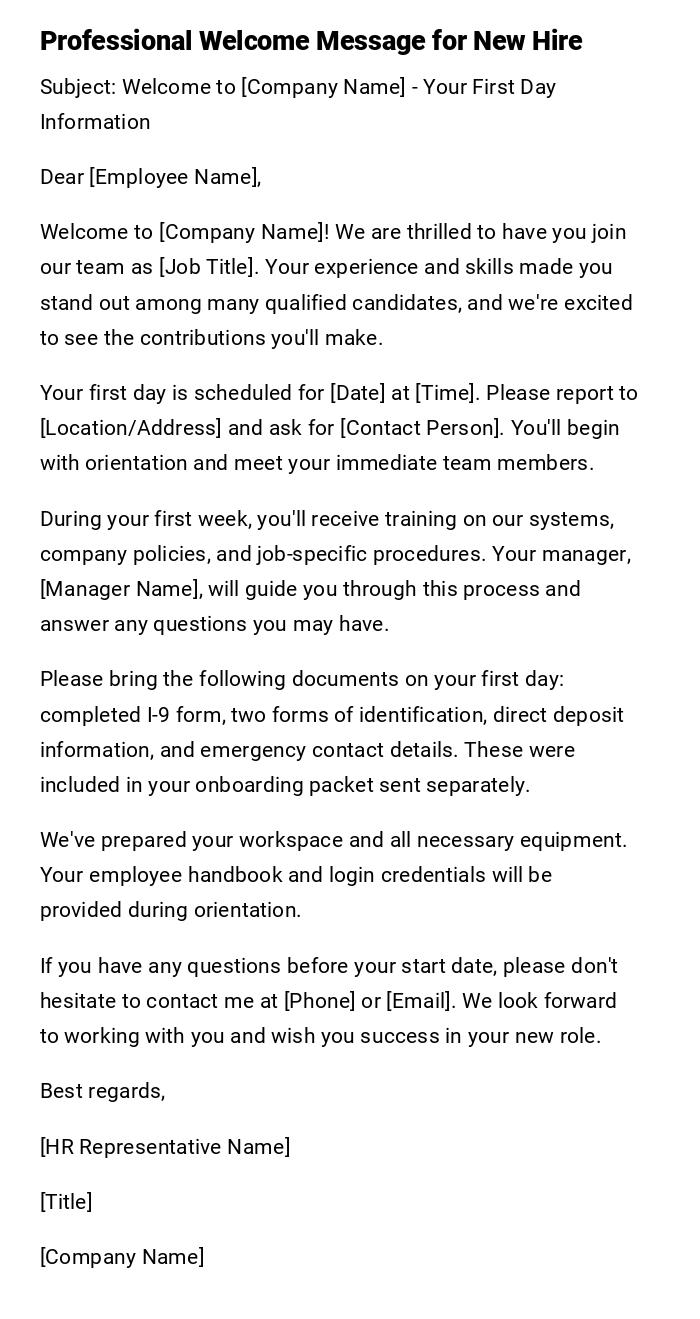
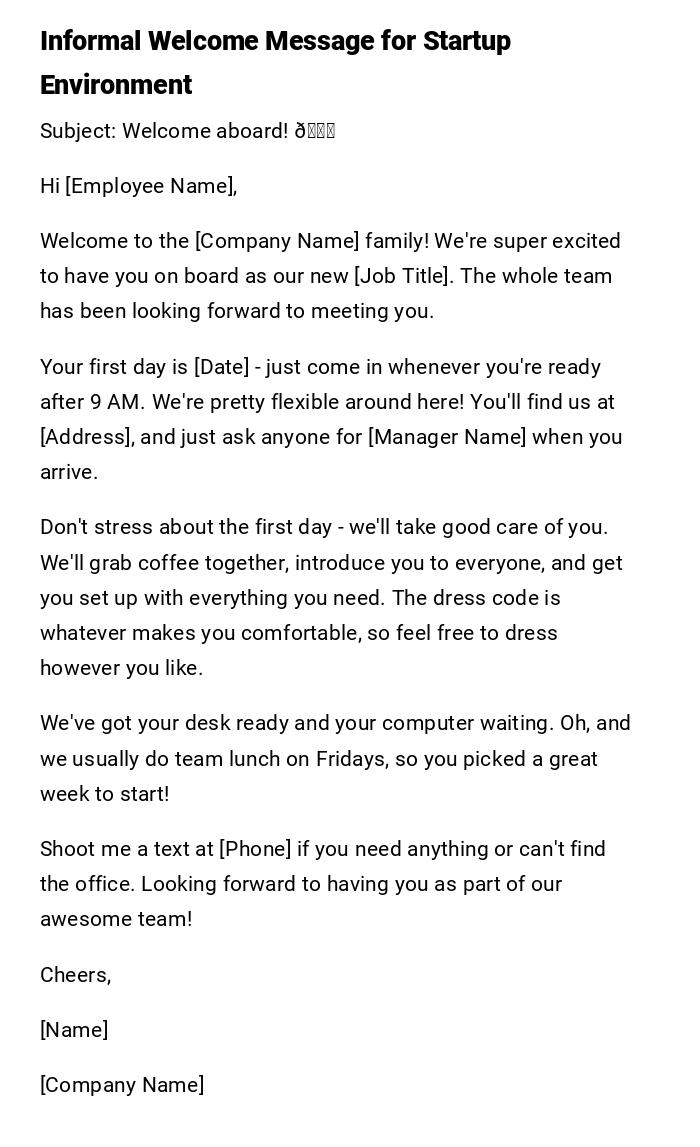
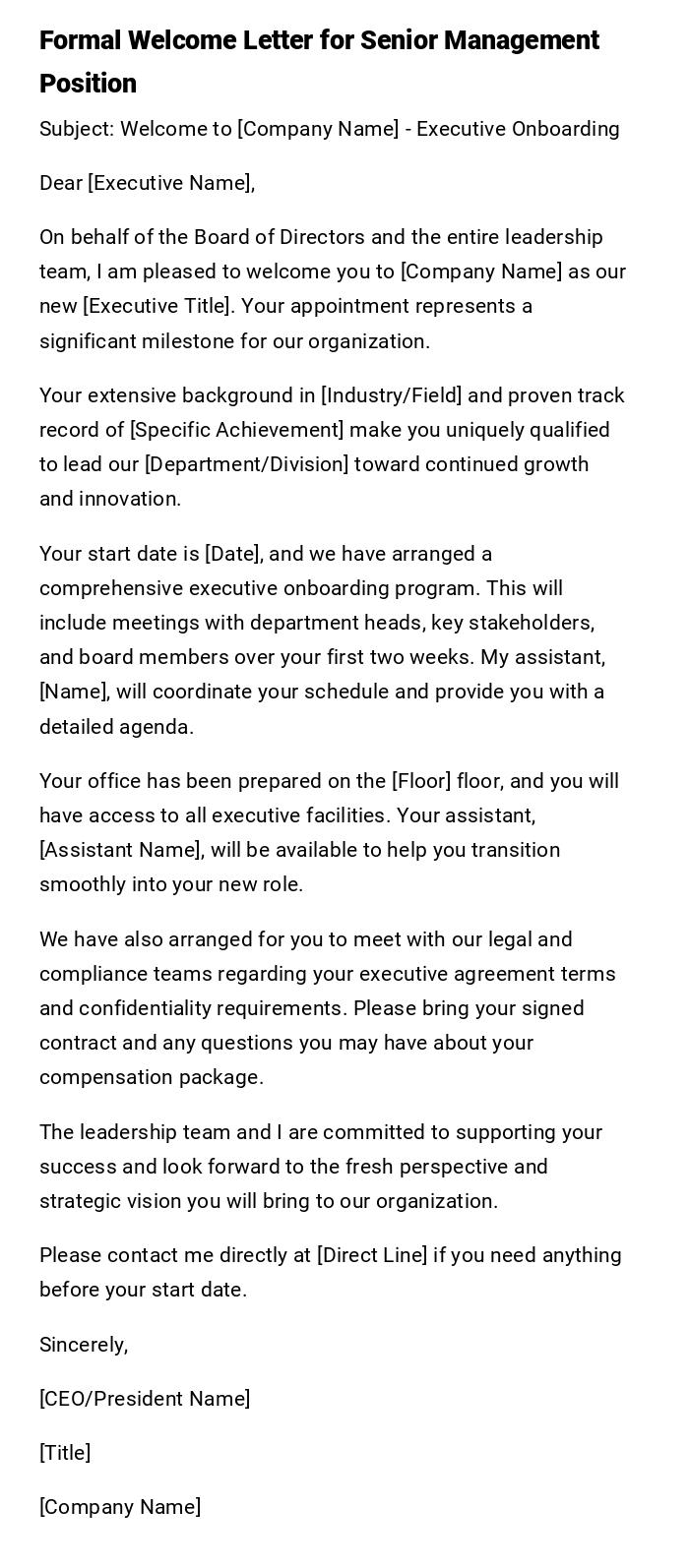
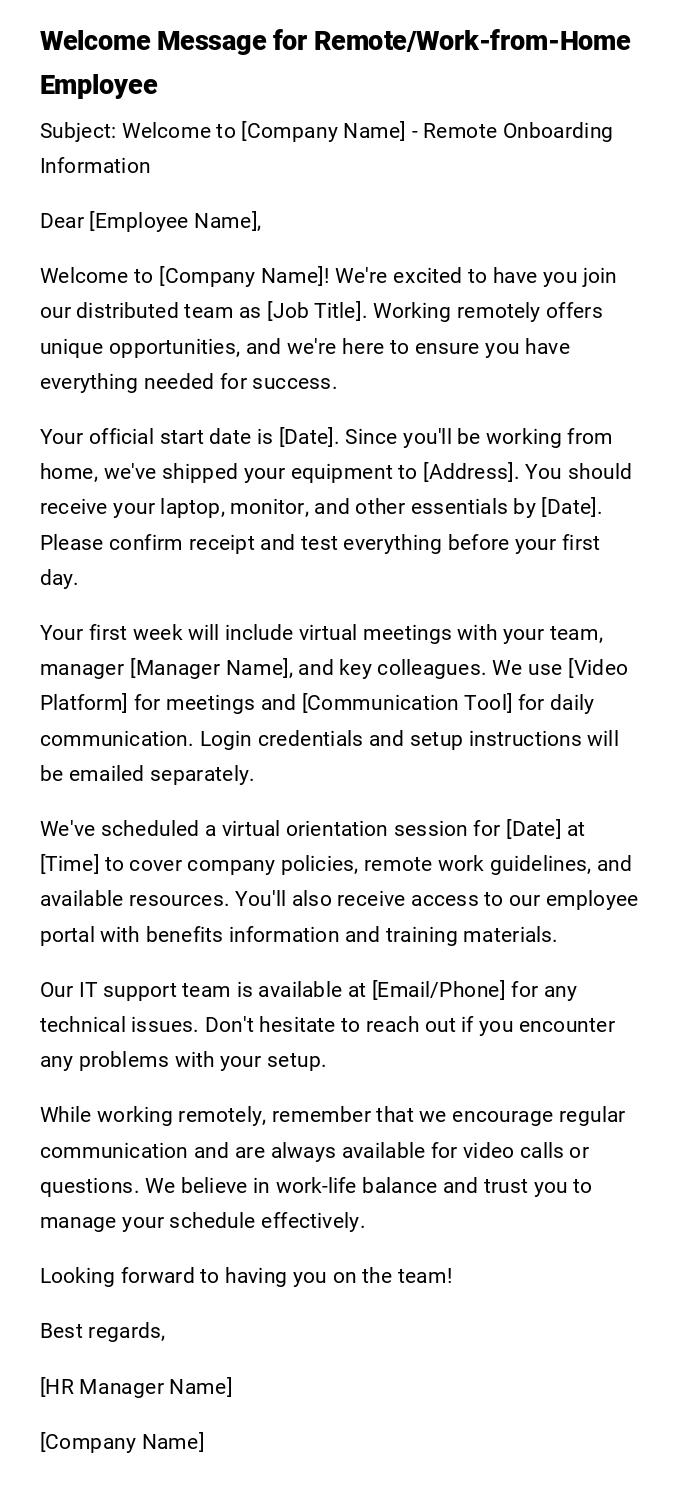
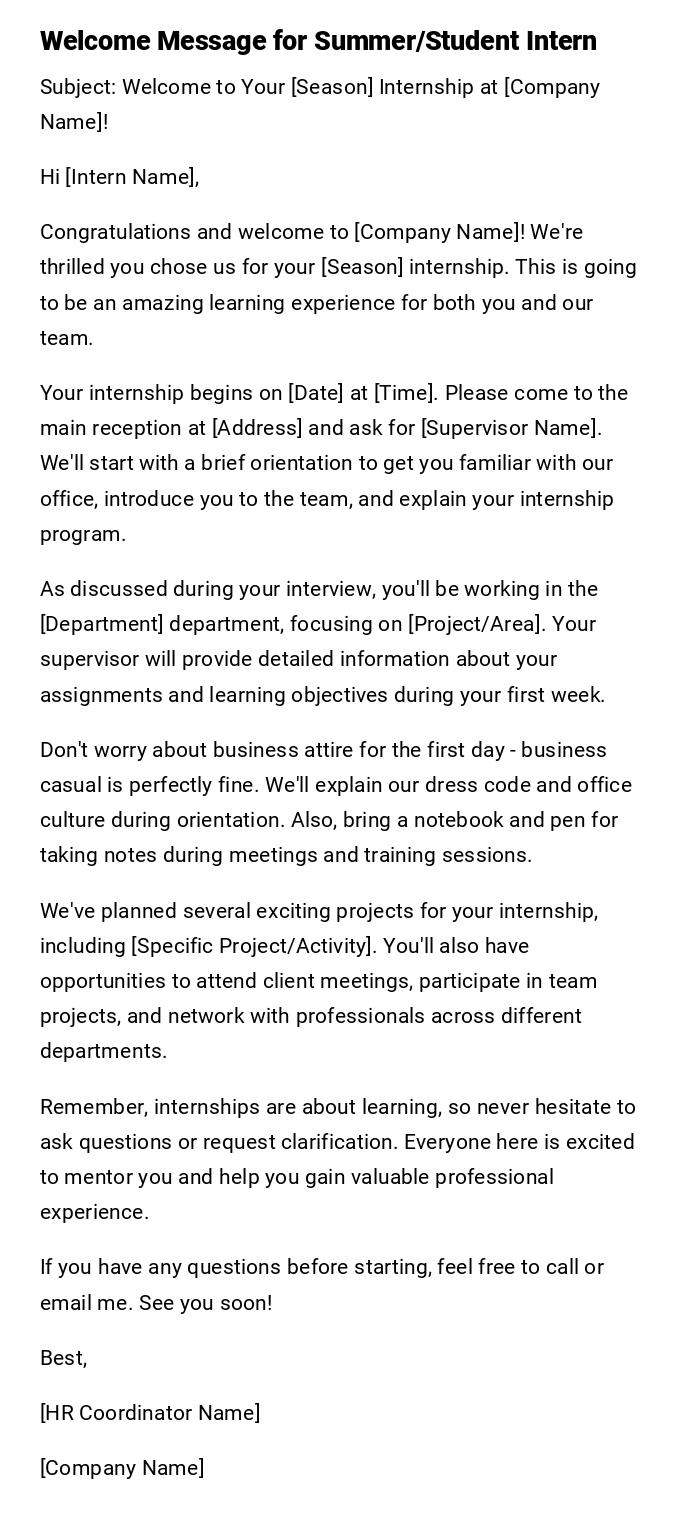
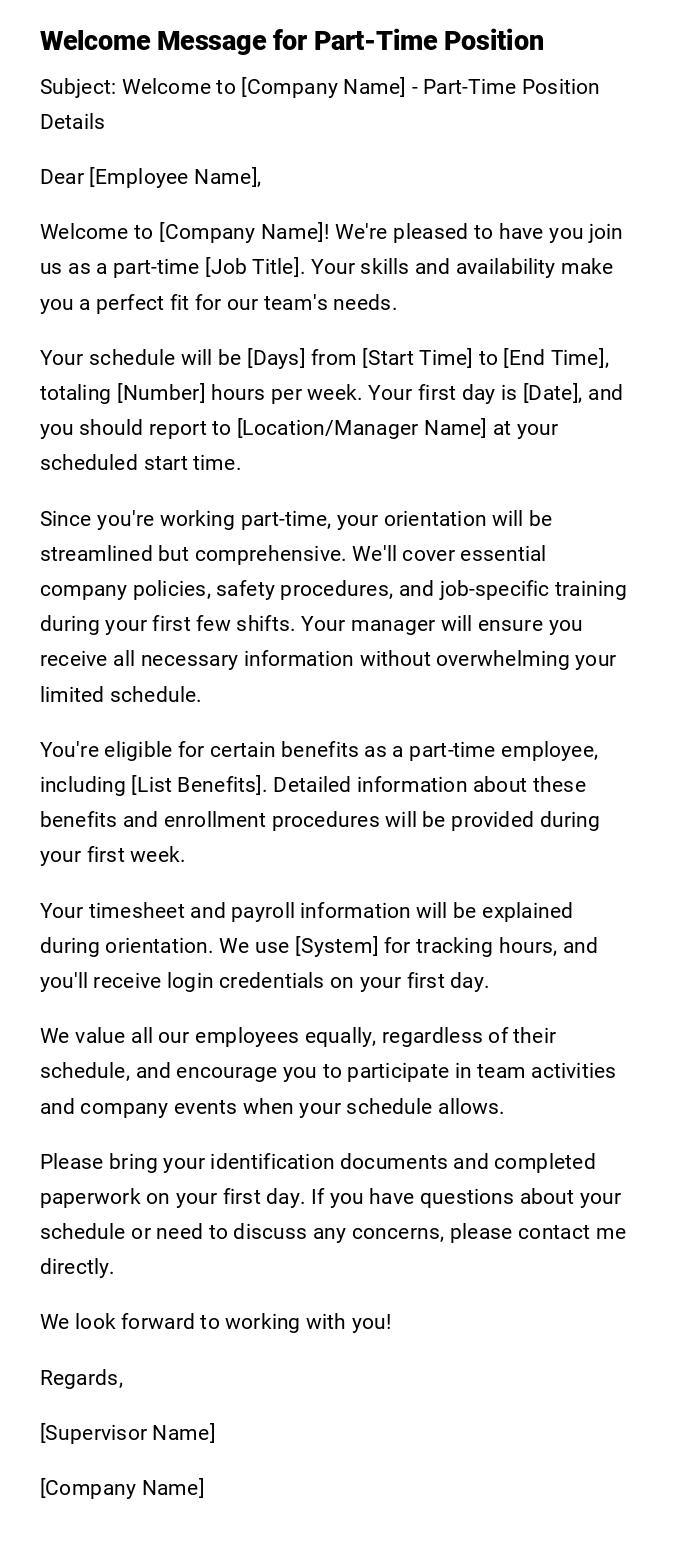
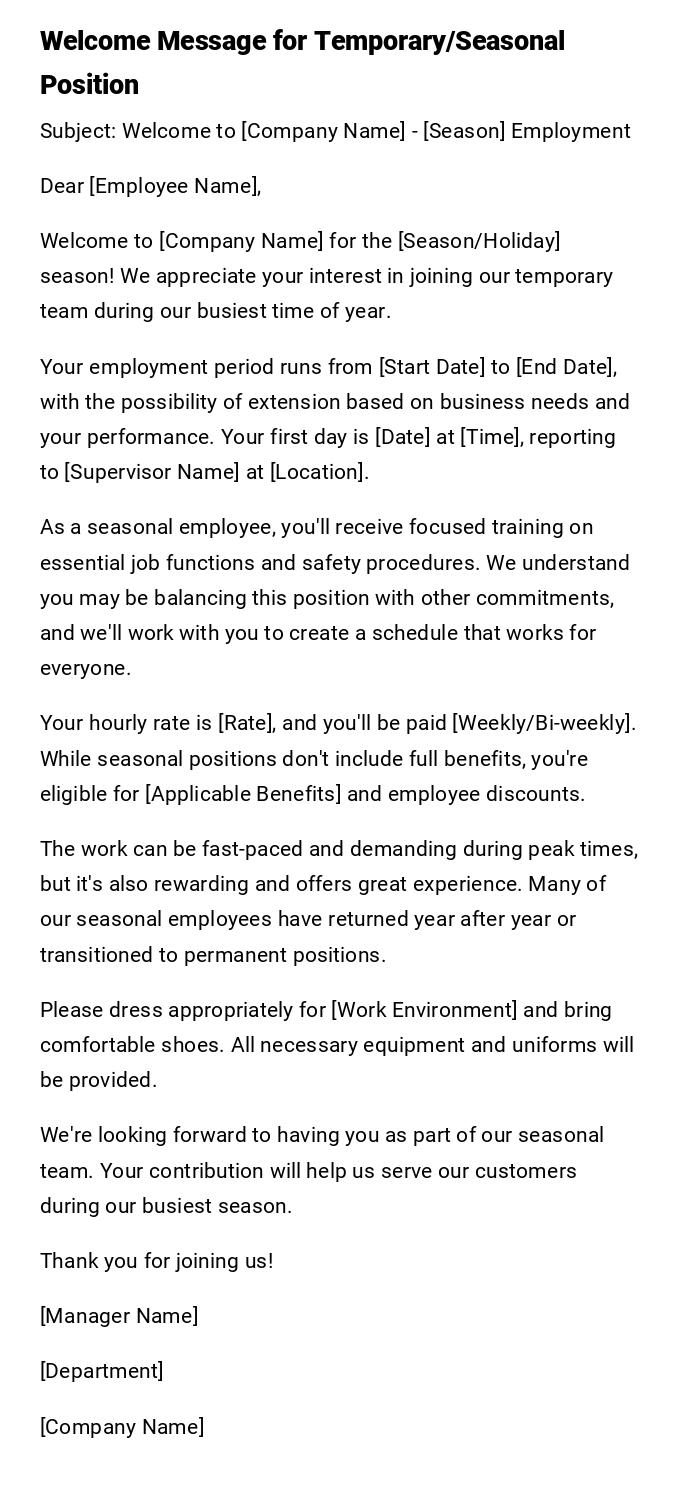
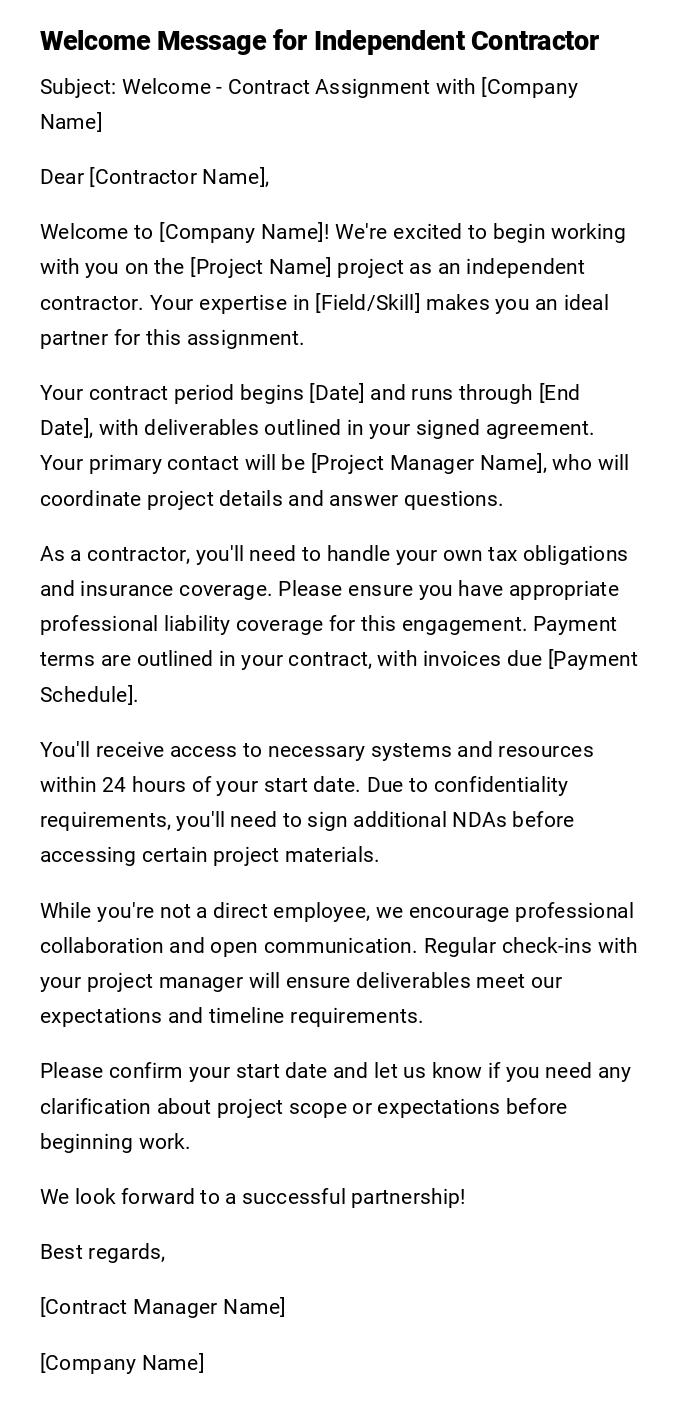

 Download Word Doc
Download Word Doc
 Download PDF
Download PDF